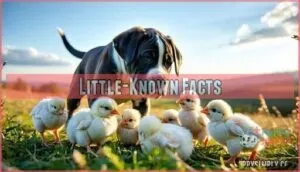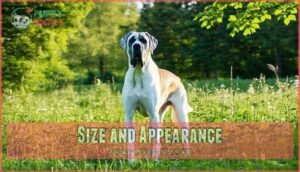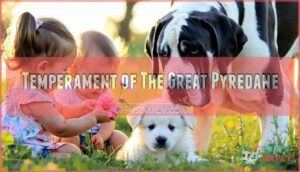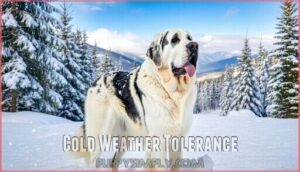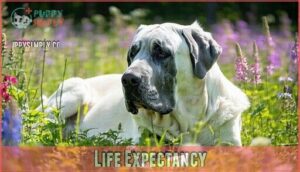This site is supported by our readers. We may earn a commission, at no cost to you, if you purchase through links.
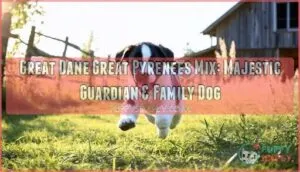
You’ll get a dog that’s surprisingly adaptable to family life despite their imposing size. These majestic guardians inherit the Great Dane’s calm temperament and the Great Pyrenees’ protective instincts, creating a loyal family protector who’s surprisingly good with children.
Their double coat sheds year-round, so you’ll need to stay on top of grooming. While they’re not apartment dogs, they’re less active than you might expect from their size.
Their intelligence makes training manageable, though their independent streak requires patience and consistency throughout their development.
Table Of Contents
- Key Takeaways
- Great Pyredane Puppies
- Little-Known Facts
- Owning a Great Pyredane
- Benefits of Mixing The Breeds
- Size and Appearance
- Temperament of The Great Pyredane
- Protective Nature of The Great Dane Great Pyrenees Mix
- Aggression of The Great Pyredane
- Training Needs
- Exercise Needs
- Mental Stimulation
- Dog and Child Friendliness
- Intelligence of The Great Pyredane
- Nutrition
- Grooming Requirements
- Drooling Levels
- Barking Levels
- Common Health Conditions
- Cold Weather Tolerance
- Life Expectancy
- Puppy Prices
- Frequently Asked Questions (FAQs)
- How big do Great Dane Pyrenees mix get?
- What is the life expectancy of a pyredane dog?
- Are great danes friendly or aggressive?
- Are Great Pyrenees mix good dogs?
- Does the Great Pyredane require a lot of exercise?
- Are Great Pyredane puppies easy to train?
- How much should a Great Pyredane be fed per day?
- What types of health conditions is the Great Pyredane prone to?
- Does the Great Pyredane have a high tolerance for cold weather?
- How much does a Great Pyredane cost?
- Conclusion
Key Takeaways
- You’ll get a surprisingly manageable giant – Despite weighing 100-160 pounds, Great Pyredanes adapt well to family life with moderate exercise needs and calm temperaments that make them easier to handle than their size suggests.
- Early socialization is crucial for success – You’ll need to start training and socializing your Great Pyredane puppy immediately to develop proper interactions with children, other pets, and strangers while managing their protective instincts.
- Budget for significant ongoing costs – You’ll spend $1,000-$2,000 upfront for a puppy, plus substantial ongoing expenses for 4-6 cups of high-quality food daily, regular grooming for their double coat, and veterinary care for breed-specific health issues.
- Expect 8-12 years with a gentle protector – You’ll have a loyal family guardian who’s naturally good with children and other pets, though you’ll need to monitor for serious health conditions like hip dysplasia, bloat, and cancer, especially after age eight.
Great Pyredane Puppies
Great Pyredane puppies captivate families with their fluffy coats and gentle temperaments.
Their breed history combines the Great Dane’s loyalty with the Great Pyrenees’ protective instincts.
These great dane great pyrenees mix babies require early puppy socialization to develop proper interactions with children and other pets.
Puppy nutrition demands high-quality large-breed formulas to support healthy puppy development. Regular veterinary care guarantees proper growth monitoring.
Great pyrenees great dane mix puppies need mental stimulation through interactive games and training. The pyredane’s calm nature makes them excellent family companions when properly socialized from puppyhood.
Little-Known Facts
You’ll discover surprising traits from both parent breeds that shape this remarkable mix’s personality and needs.
Understanding these lesser-known characteristics helps you appreciate why Great Pyredanes make such unique companions for the right families.
Great Dane Side
Your Great Pyredane’s Great Dane side brings fascinating Dane History dating back to ancient civilizations.
This gentle soul combines Giant Size with remarkable loyalty, creating an ideal family companion.
The large ears inherited from Great Dane genetics contribute to their expressive appearance, while their dense coat provides weather protection.
Your great dane pyrenees mix showcases the Great Dane’s obedient nature and willingness to please.
This large breed mix demonstrates the giant breed dog’s characteristic calm demeanor, making your great dane mix perfect for families seeking a devoted guardian with exceptional temperament.
Your great dane mix is a perfect example of a devoted guardian with a unique blend of characteristics from both parent breeds.
Great Pyrenees Side
Your Great Pyrenees mix inherits mountain origins spanning 10,000 years, bringing ancient guard traits and herding instinct to your home.
This protective nature stems from generations of livestock protection in harsh terrain, making your Great Pyredane naturally watchful. The Pyrenees great dane combination creates flock behavior tendencies—your dog may try "herding" family members or guests.
These guardian genetics mean your pyrenees dane mix can be aloof with strangers but devoted to their pack. While friendly with familiar faces, that protective nature kicks in when sensing threats.
Your great pyrenees mix balances independence with loyalty, creating a companion who’s both gentle family member and formidable protector when needed.
Appearance Changes
Your great dane pyrenees mix will undergo remarkable Physical Development as he matures from puppyhood to adulthood.
While puppies start as fluffy bundles of fur, Coat Variations become apparent as they mature. The double coat undergoes significant changes – the initial fluffy coat gradually shortens and develops distinct Color Shifts ranging from white to gray with potential black markings.
Fur Texture evolves from soft puppy fuzz to a dense, weather-resistant adult coat. Size Changes are equally dramatic, with that adorable ball of fluff growing into a massive companion.
The shedding patterns intensify as the coat texture matures, requiring adjusted grooming routines. These coat texture transformations reflect the complex genetics inherited from both parent breeds, creating unique appearances in each individual.
Suitability for Families
Your gentle giant thrives in Family Dynamics with proper Child Safety measures and early socialization.
This loyal companion adapts well to various Family Lifestyle situations, making excellent family pets through consistent training.
Their dog and child friendliness shines with supervision, while their calm temperament supports positive Household Adaptation.
Early socialization guarantees your family dog becomes the perfect gentle giant for most family pets.
Compatibility With Other Pets
Your Great Pyredane excels in multi-pet homes thanks to their gentle giant nature and exceptional animal socialization skills.
This family dog’s protective instincts extend to all household pets, creating remarkable pet harmony through natural coexisting strategies. With proper socialization training, they can thrive in diverse pet environments.
Key Benefits for Household Dynamics:
- Nurturing Protection – They guard smaller pets like cats and rabbits as part of their "flock"
- Playful Companionship – Joins games without aggressive behavior toward family pets
- Gentle Giants – Their size paired with careful movements prevents accidental harm
- Early Bonding – Socialization from puppyhood guarantees lifelong canine friendliness
- Peaceful Coexistence – Rare chasing behavior makes them ideal for diverse pet families
Owning a Great Pyredane
Owning a Great Pyredane requires commitment to managing their substantial size and specific care requirements.
You’ll need to provide proper nutrition, regular exercise, consistent training, thorough grooming, and proactive health monitoring to guarantee your gentle giant thrives as a family companion, ensuring they receive the necessary care to live a healthy life with proper nutrition.
Food and Diet
In regards to Nutrition Facts and Diet Plans, your Pyredane thrives on high-quality dog food, ideally a grain-free brand.
A Feeding Schedule of 4–6 cups daily, split into two Meal Portions, supports their size and energy.
Watch for Food Allergies, as sensitive stomachs aren’t rare.
Balanced nutrition keeps joints strong—think of it as fueling a gentle giant’s engine.
Choosing the right grain free options is vital for maintaining healthy health in your Great Pyredane.
Exercise
After meeting your dog’s nutrition needs, focus on exercise routines to keep your Great Pyredane happy and healthy.
Their exercise requirements aren’t extreme, but regular activity is key.
Try these:
- Daily walks for cardiovascular health.
- Outdoor activities like fetch or tug-of-war.
- Short playtime needs and mental games for physical stimulation.
Balance is everything—think marathon, not sprint.
Training
Training your Great Pyredane requires consistent obedience training with positive reinforcement techniques.
Start socialization strategies early, exposing your pup to various environments and people.
Use reward-based training for basic obedience commands like sit, stay, and come.
Housebreaking methods should focus on routine and patience.
Leash training prevents pulling issues common in large breeds.
Behavior modification helps address stubborn tendencies inherited from both parent breeds through structured sessions.
Grooming
Your Great Pyredane’s double coat demands consistent attention to maintain its majestic appearance.
This breed’s moderate shedding requires strategic coat care to prevent matting and reduce loose fur throughout your home.
Essential grooming tasks include:
- Brushing 2-3 times weekly using proper brushing techniques to manage the dense undercoat
- Nail trimming every 6-8 weeks to prevent overgrowth and discomfort
- Ear cleaning weekly to prevent infections in those large, floppy ears
Regular shedding control through consistent brushing helps maintain your dog’s coat quality while keeping your furniture fur-free.
Effective dog brush tools are necessary for proper grooming and coat maintenance, utilizing a dog grooming routine.
Health and Conditions
Several serious health conditions can affect your Great Pyredane throughout their lifetime.
Hip dysplasia causes joint pain and mobility issues, while bloat risk requires immediate veterinary attention.
Cancer signs become more common after age eight, particularly osteosarcoma affecting bones.
Heart problems and wobblers syndrome, causing unsteady gait, also occur.
Choose reputable breeders who screen for these genetic conditions to maximize your dog’s health potential.
Responsible breeding also involves checking for genetic health issues to guarantee the well-being of the dogs.
Benefits of Mixing The Breeds
When you combine the Great Dane and Great Pyrenees, you’re getting the best of both worlds through hybrid vigor. This genetic strength comes from crossbreeding advantages that often reduce inherited health problems common in purebred lines.
The breed diversity creates mixed traits that balance the Great Dane’s friendly nature with the Great Pyrenees’ protective instincts. Your great pyrenees mix won’t be as hyperactive as a pure Great Dane, yet they’ll be more social than a typical Great Pyrenees.
This great dane pyrenees combination produces a gentle giant that’s both guardian and companion. You’ll also benefit from potentially low shedding compared to purebred Great Pyrenees, though they’re not fully hypoallergenic.
The mixed genetics often create dogs with fewer extreme traits – they’re large but not as massive as some Great Danes, protective but not overly territorial like some Great Pyrenees. This balanced temperament makes them adaptable family dogs.
Understanding the importance of breed mixing benefits is vital for any dog owner.
Size and Appearance
Looking at this majestic great pyrenees mix, you’ll notice their impressive size immediately commands attention.
Males typically reach 29-33 inches tall and weigh 95-120 pounds, while females stand 27-31 inches and weigh 80-105 pounds.
The great dane pyrenees combines the best physical traits from both large breeds, creating a truly striking appearance.
Their head shape is distinctly rectangular and well-chiseled, giving them a noble expression that’s hard to ignore.
You’ll find their almond-shaped eyes enchanting, whether they’re brown or blue.
Ear size is moderate with triangular, floppy ears that frame their face perfectly.
The tail length extends long and straight, completing their balanced body type.
Coat colors vary beautifully across white, fawn, black, blue, and brindle patterns.
Their medium to long coat provides weather resistance while maintaining that fluffy texture everyone loves.
This muscular, athletic build reflects both parent breeds’ strength and elegance.
The smoothly muscled body features a deep chest and powerful neck, showcasing why these dogs make such impressive guardians.
Temperament of The Great Pyredane
Your Great Pyredane’s temperament blends the best of both worlds, creating a loyal companion with remarkable emotional intelligence.
These gentle giants display incredible patience around children, yet maintain strong protective instincts when needed.
Their social behavior tends toward reserved independence, making them excellent judges of character who warm up gradually to newcomers.
Intelligence shines through their ability to read situations and respond appropriately.
While they’re naturally calm and even-tempered, great pyredane puppies require early socialization to develop proper temperament balance.
Their gentle nature makes them ideal family dogs, though they can become overprotective if not properly guided.
Loyalty traits run deep in this mix, creating dogs who form strong bonds with their families.
They’re sensitive to their owner’s emotions and respond with remarkable intuition.
Unlike some giant breeds, they rarely display aggression without cause, preferring to assess situations before reacting.
This measured approach reflects their mountain dog heritage combined with the Great Dane’s noble disposition.
They’re loyal companions with a unique blend of gentle nature and strong protective instincts, making them a great addition to any family.
Protective Nature of The Great Dane Great Pyrenees Mix
Your Great Pyredane’s protective nature stems from powerful Guard Dog Traits inherited from both parent breeds.
These gentle giants blend fierce loyalty with mountain-born guardian instincts, creating nature’s perfect family protector.
The Great Pyrenees lineage contributes livestock guardian instincts, while the Great Dane brings natural watchdog abilities.
This combination creates a loyal guardian who’ll stand between your family and potential threats without hesitation.
These dogs exhibit moderate Stranger Waryness, evaluating newcomers carefully before warming up.
Their Protective Instincts manifest through alert positioning and calm observation rather than immediate aggression.
You’ll notice your Great Pyredane’s Loyalty Levels run deep – they’re fiercely protective of their pack.
Their Family Defense mechanisms include:
- Positioning themselves between family members and unfamiliar visitors
- Using their imposing size as a natural deterrent
- Maintaining constant awareness of their surroundings
- Alerting through deep, resonant barks when necessary
- Showing increased vigilance during evening hours
This protective nature makes them excellent companions for families seeking a gentle giant who takes their security role seriously.
Aggression of The Great Pyredane
While your Great Dane Pyrenees mix has a protective nature, understanding their potential for aggressive behavior helps you manage this loyal guardian effectively.
The Great Pyredane isn’t naturally aggressive, but their strong protective instincts can manifest as territorial responses when they perceive stranger danger.
Fear aggression typically occurs when your dog feels cornered or threatened, especially if they haven’t been properly socialized. You’ll notice warning signs like intense staring, growling, or your dog adopting a defensive posture between you and perceived threats.
This behavior stems from their guardian heritage rather than inherent aggression.
Most Great Dane Pyrenees mixes become overprotective of children and household pets, sometimes reacting defensively toward unfamiliar visitors. Pain from conditions like hip dysplasia can also trigger sudden behavioral changes.
Early socialization prevents most aggressive tendencies, helping your dog distinguish between real threats and harmless situations. Professional intervention becomes necessary if protective behavior escalates beyond manageable levels.
Training Needs
Training your Great Pyredane requires patience and consistency, as this intelligent mix combines the Great Dane’s willingness to please with the Great Pyrenees’ independent streak.
You’ll need to start early with both potty training and obedience work, since their large size makes correcting bad habits much more challenging once they’re fully grown.
Potty Training
Patience becomes your greatest asset when potty training your Great Pyredane puppy.
These gentle giants respond best to consistent potty schedules with outdoor breaks every 2-3 hours, especially after meals and naps.
Establish a designated bathroom area outside and use reward-based training with treats and praise when they succeed.
Housebreaking tips include watching for sniffing or circling behaviors that signal they need to go.
Accident prevention starts with supervising your puppy closely during the first few weeks.
Clean accidents thoroughly with enzyme cleaners to eliminate odors that might attract repeat incidents.
Crate training supports the process since dogs naturally avoid soiling their sleeping space.
Remember, larger breeds like Great Pyredanes may take longer to develop full bladder control, so expect the process to take 4-6 months with consistent effort.
Obedience Training
Successful obedience training requires consistent positive reinforcement and clear house rules from day one.
Your Great Pyredane responds best to reward-based training methods, making basic commands like "sit" and "stay" achievable within weeks.
Clicker training proves especially effective for this intelligent mix, while leash manners prevent pulling during walks.
Despite moderate training difficulty, patience pays off—these gentle giants want to please you.
Start with short sessions to avoid overwhelming your pup, and remember that consistency beats intensity every time.
Exercise Needs
Your Great Pyredane requires regular exercise but not excessive amounts.
Daily walks and short bursts of activity work best—think 4-6 sessions of 10 minutes each rather than marathon workouts.
These gentle giants need physical activity suited to their size and joint health.
Exercise routines should include leisurely strolls and controlled playtime needs to prevent overexertion.
Weather matters too—hot days mean shorter sessions, cold days require extra warmth.
Remember, exercise levels should match their laid-back personality while maintaining fitness.
Mental Stimulation
Your Great Pyredane’s sharp intelligence requires consistent mental stimulation to prevent boredom and destructive behaviors.
These gentle giants possess remarkable problem-solving abilities that need regular engagement through structured activities.
Here are three essential mental stimulation strategies:
- Puzzle Toys and Brain Games – Rotate interactive toys that challenge their cognitive abilities and reward problem-solving efforts
- Interactive Play Sessions – Engage in hide-and-seek games, scent work, and training exercises that combine physical and mental challenges
- Mental Exercises Through Trainability – Teach new commands, practice obedience routines, and introduce complex tricks that utilize their natural intelligence
Without adequate mental stimulation, your Great Pyredane may develop anxiety or exhibit unwanted behaviors like excessive barking or chewing.
Effective dog training uses positive reinforcement techniques to encourage good behavior and strengthen the bond between dog and owner.
Dog and Child Friendliness
Great Pyredanes excel as gentle giants with exceptional child safety records and family dynamics.
These fantastic family pets demonstrate remarkable kid compatibility, making them ideal loving companions for households with children.
Their patient temperament and protective instincts create positive pet interaction experiences.
| Age Group | Supervision Level | Interaction Benefits |
|---|---|---|
| Toddlers (2-4) | High supervision required | Teaches empathy, responsibility |
| School age (5-12) | Moderate supervision | Builds confidence, companionship |
| Teenagers (13+) | Minimal supervision | Develops leadership skills |
| Adults | Independent interaction | Stress relief, emotional support |
However, their massive size requires careful monitoring around small children to prevent accidental knockdowns.
Early socialization helps these loyal companions understand appropriate play behavior.
Their child friendliness stems from the Great Pyrenees’ natural guardian instincts combined with the Great Dane’s gentle nature, creating family pets that instinctively protect while remaining calm and affectionate during daily interactions.
This unique blend makes them ideal loving companions for families, offering stress relief and emotional support to all members.
Intelligence of The Great Pyredane
Most Great Pyredanes display above-average intelligence, though their cognitive function can be tricky to assess.
These dogs inherit sharp problem solving abilities from both parent breeds, making them capable of independent decision-making that sometimes looks like stubbornness.
Their learning ability tends to be selective – they’ll quickly master concepts they find valuable but may ignore commands they deem unnecessary.
The Great Pyredane’s trainability depends heavily on your approach.
Their adaptive intelligence means they’ll figure out your routines and expectations, but traditional obedience training requires patience.
They’re not keen-to-please dogs like Labs; instead, they evaluate whether your requests make sense from their perspective.
Their dog intelligence shines through environmental awareness and protective instincts.
They’ll remember faces, assess threats, and make calculated decisions about when to act.
This independent thinking can frustrate owners expecting immediate compliance, but it’s actually a sign of their sophisticated mental processing capabilities.
Nutrition
Your Great Pyredane needs a carefully balanced diet to support their massive frame and prevent common health issues like bloat and joint problems.
You’ll want to focus on high-quality large-breed formulas while being mindful of table scraps, treats, and supplements that can impact their overall nutrition.
Table Scraps
Feeding table scraps to your Great Dane Great Pyrenees mix can backfire spectacularly. While it’s tempting to share your meal, human food poses serious risks to your dog’s health and well-being.
Three critical reasons to avoid table scraps:
- Pancreatitis risk – High-fat foods can trigger this painful, potentially life-threatening condition
- Toxic ingredients – Common foods like chocolate, onions, and garlic are dangerous to dogs
- Behavioral problems – Regular feeding creates persistent begging and food-stealing habits
Table scraps disrupt proper dog nutrition by adding excessive calories and unbalanced nutrients. Your great dane great pyrenees mix requires specific meal planning with premium dog food designed for large breeds.
Even small portions of human food can equal hundreds of calories for dogs. Maintaining consistent feeding habits with appropriate dog diet choices prevents obesity and digestive issues.
Food safety means sticking to veterinarian-approved nutrition plans rather than sharing your dinner plate.
Dog Treats
Quality dog treats serve as powerful training tools and nutritional supplements for your Great Pyredane.
Choose freeze-dried snacks rich in protein or homemade treats made with wholesome ingredients like sweet potato and lean meats. Dental chews promote oral health while satisfying their natural chewing instincts.
For ideal nutrition, consider using freeze dried products to supplement their diet.
| Treat Type | Benefits | Frequency |
|---|---|---|
| Freeze-Dried Snacks | High protein, long shelf life | 2-3 times daily |
| Homemade Treats | Fresh ingredients, cost-effective | Weekly batches |
| Dental Chews | Oral health, plaque reduction | 3-4 times weekly |
| Training Rewards | Behavior reinforcement | During sessions |
| Nutritional Biscuits | Vitamin enrichment | 1-2 daily |
Supplements
After choosing the right dog treats, it’s smart to think about supplements for your Great Pyredane’s overall well-being.
Vitamin needs like vitamin E and C supplements support immune health, while mineral supplements aid bone strength.
Joint care formulas and digestive aids help keep those big bodies moving smoothly.
Nutrient boosters, especially for females, can include citrus fruits for a little extra digestive health.
Grooming Requirements
After you’ve sorted your dog’s nutrition, grooming keeps your Great Dane-Great Pyrenees mix looking and feeling its best.
Their dense, weather-resistant coat needs consistent care to avoid matting and excessive shedding.
Here’s your checklist:
- Bathe monthly, adjusting for activity and climate.
- Brush three times weekly using proper brushing techniques for Coat Maintenance and Shedding Control.
- Inspect and clean ears weekly to prevent infection.
- Brush teeth regularly for dental health.
- Trim nails every 2-3 weeks, avoiding overgrowth and discomfort.
A well-groomed pup means fewer tangles and a happier companion.
Drooling Levels
Great Pyredane drooling levels vary substantially between individual dogs, with genetics playing the primary role in saliva quantity.
While Great Danes typically produce moderate drool, the Great Pyrenees contributes lower slobber tendencies to this mix. Most Pyredanes fall into the light-to-moderate drooling category, though males often exhibit higher saliva production than females.
Effective drool reduction strategies include regular mouth care, keeping water bowls clean, and using absorbent bandanas during peak drooling times. Drooling issues rarely indicate health problems in this breed, making saliva management straightforward for most owners seeking practical slobber control solutions.
It’s also vital to monitor overall health, watching for signs of dog lethargic behavior that could signal underlying issues.
Barking Levels
Your Great Pyredane won’t bark constantly, but they’ll definitely speak up when something’s amiss. These gentle giants inherit vocal traits from both parent breeds, making bark control essential for harmonious living.
Understanding your great dane mix’s barking patterns helps you manage noise levels effectively:
- Alert barking – Quick bursts when strangers approach the property
- Protective barking – Deeper, more sustained sounds during perceived threats
- Attention-seeking barking – Short, repetitive sounds when wanting interaction
- Boredom barking – Prolonged episodes from insufficient mental stimulation
- Territorial barking – Consistent patterns when defending their space
Sound reduction techniques work best when you understand your great pyrenees mix’s specific triggers. These dogs respond well to positive reinforcement training that teaches appropriate vocal behavior. Great pyredane puppies benefit from early socialization to minimize excessive barking tendencies. Their dog behavior typically involves moderate vocalization rather than constant noise-making.
Common Health Conditions
Beyond routine checkups, your Great Pyredane faces specific health challenges that require vigilant monitoring.
Hip dysplasia affects many large breeds, causing joint pain and mobility issues that worsen with age.
Bloat risks run particularly high in giant breeds—this life-threatening condition can develop within hours when the stomach twists.
Wobblers syndrome creates a characteristic unsteady gait as spinal compression affects coordination.
Osteosarcoma, a aggressive bone cancer, strikes frequently after age eight, especially in dogs with Great Pyrenees genetics.
Heart problems including dilated cardiomyopathy can develop silently, making regular cardiac screening essential.
Cancer becomes the leading cause of death in older Great Pyredanes, with risk increasing dramatically after eight years.
Early detection through routine dog health screenings gives you the best chance of managing these conditions effectively, especially life-threatening condition, joint pain, and regular cardiac screening to prevent heart problems.
Cold Weather Tolerance
Your Great Dane Great Pyrenees Mix thrives in cold weather conditions, making winter adventures a joy rather than a chore. The breed’s thick double coat provides excellent insulation against freezing temperatures, transforming your pup into a walking furnace that actually prefers colder climates over sweltering summer heat.
Understanding your dog’s cold weather tolerance helps you make informed decisions about outdoor activities:
- Coat Thickness: Dense undercoat traps warm air, creating natural thermal protection
- Hypothermia Risk: Minimal due to breed adaptations, but monitor for excessive shivering
- Winter Exercise: Maintains energy levels better in cold than hot weather
- Breed Adaptations: Great Pyrenees genetics contribute superior cold tolerance
- Shelter Needs: Adequate windbreak and dry bedding sufficient for most conditions
While your Great Pyredane handles cold like a champ, make certain proper grooming to maximize coat effectiveness. Regular brushing prevents matting that reduces insulation. Even with their tolerance, it’s essential to watch for signs of cold-related health issues. Watch for ice buildup between toes during winter walks.
Life Expectancy
Your Great Pyredane’s lifespan typically ranges from 8-12 years, with genetics playing a major role in longevity.
Breed genetics from both parent lines influence life expectancy, while size influence generally shortens lifespans in giant breeds.
Preventative care including regular vet checkups helps catch health concerns early.
Genetic screening of breeding parents reduces inherited conditions.
Cancer risk increases substantially after age eight, particularly from the Great Pyrenees lineage.
Proper nutrition, exercise, and weight management directly impact your dog’s longevity potential.
Puppy Prices
Anyone considering a Great Pyredane should budget $1,000-$2,000 for puppies.
Breeder reputation substantially impacts pricing, with established breeders charging premium rates for health-tested parents and genetic guarantees.
Location impact varies regionally, while pedigree influence from AKC-registered parents increases costs.
Coat color preferences and gender variance affect final breeder fees.
Key pricing factors include:
- Breeder reputation and health clearances
- Geographic location and local demand
- Training level and socialization exposure
Avoid puppy mills offering suspiciously low prices—quality breeders invest in proper care, making their puppies worth the investment for your family’s long-term happiness.
Frequently Asked Questions (FAQs)
How big do Great Dane Pyrenees mix get?
You’ll find these gentle giants stand 27 to 34 inches tall at the shoulder and tip the scales between 90 and 160 pounds.
That’s more dog than lap, so clear some space—your couch may never be the same!
What is the life expectancy of a pyredane dog?
Like a candle’s flame flickering in the wind, your Pyredane’s lifespan typically ranges from 8-12 years.
Large breed genetics contribute to this shorter lifespan, with health risks increasing after age eight due to inherited conditions.
Are great danes friendly or aggressive?
Great Danes are generally friendly, gentle giants known for their calm, patient temperament. They’re excellent family dogs but need early socialization to prevent wariness around strangers.
Are Great Pyrenees mix good dogs?
You’ll find these gentle giants make excellent family companions. They’re naturally protective yet patient with children, combining loyalty with an even-tempered disposition that’s perfect for households seeking devoted guardians.
Does the Great Pyredane require a lot of exercise?
Think of a marathon runner who’s content with a leisurely jog—that’s your Great Pyredane’s exercise philosophy.
You’ll need moderate daily activity, not intensive workouts.
Short bursts work best for these gentle giants.
Are Great Pyredane puppies easy to train?
Training these gentle giants requires patience and consistency.
They’re intelligent but can be stubborn, inheriting independence from their Great Pyrenees lineage.
You’ll need early socialization and positive reinforcement for best results.
How much should a Great Pyredane be fed per day?
You’ll need to provide 4-6 cups of high-quality large-breed dog food daily for your Great Pyredane. Split this into two meals to prevent bloat, a serious condition in giant breeds.
What types of health conditions is the Great Pyredane prone to?
Over 60% of Great Pyredanes develop hip dysplasia by age five. You’ll face bloat, osteosarcoma, heart conditions, Wobblers syndrome, and cancer risks after eight years, requiring vigilant veterinary monitoring.
Does the Great Pyredane have a high tolerance for cold weather?
Your Great Pyredane’s thick, weather-resistant double coat provides excellent insulation against cold temperatures, making them well-suited for winter climates and outdoor activities in chilly conditions.
How much does a Great Pyredane cost?
Hold onto your wallet—these gentle giants’ll cost you a small fortune.
You’re looking at $500-$2,000 for a Great Pyredane puppy, depending on breeder reputation and lineage.
Don’t forget ongoing expenses: food, vet bills, and grooming add up quickly for these magnificent, oversized companions.
Conclusion
Like a gentle giant guardian angel, the Great Dane Great Pyrenees mix offers families an exceptional companion who balances protective instincts with remarkable gentleness.
You’ll find this breed’s calm temperament and moderate exercise needs make them surprisingly manageable despite their imposing 100-160 pound frame.
Their intelligence facilitates training, though patience remains essential during their independent phases.
With proper grooming, nutrition, and healthcare, you’ll enjoy 8-10 years with this magnificent breed that perfectly exemplifies the phrase "gentle giant.


